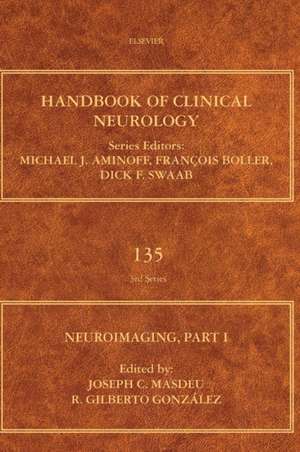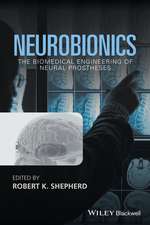Neuroimaging, Part I: Handbook of Clinical Neurology, cartea 135
Joseph C. Masdeu, R. Gilberto Gonzalezen Limba Engleză Hardback – 27 iul 2016
This first volume specifically covers a description of imaging techniques used in the adult brain, aiming to bring a comprehensive view of the field of neuroimaging to a varying audience. It brings broad coverage of the topic using many color images to illustrate key points.
Contributions from leading global experts are collated, providing the broadest view of neuroimaging as it currently stands. For a number of neurological disorders, imaging is not only critical for diagnosis, but also for monitoring the effect of therapies, and the entire field is moving from curing diseases to preventing them. Most of the information contained in this volume reflects the newness of this approach, pointing to this new horizon in the study of neurological disorders.
- Provides a relevant description of the technologies used in neuroimaging, including computed tomography (CT), magnetic resonance imaging (MRI), positron emission tomography (PET), and several others
- Ideal resource for anyone studying the nervous system, from beginners to specialists interested in recent advances in neuroimaging of the adult brain
- Discusses the application of imaging techniques to the study of brain and spinal cord disease and its use in various syndromes
- Contains vibrant, colorful images to illustrate key points
Din seria Handbook of Clinical Neurology
- 20%
 Preț: 1274.52 lei
Preț: 1274.52 lei - 20%
 Preț: 1311.43 lei
Preț: 1311.43 lei - 23%
 Preț: 1286.74 lei
Preț: 1286.74 lei - 20%
 Preț: 1344.20 lei
Preț: 1344.20 lei - 20%
 Preț: 1349.51 lei
Preț: 1349.51 lei - 24%
 Preț: 1275.78 lei
Preț: 1275.78 lei - 20%
 Preț: 1344.02 lei
Preț: 1344.02 lei - 20%
 Preț: 1339.70 lei
Preț: 1339.70 lei - 20%
 Preț: 1316.98 lei
Preț: 1316.98 lei - 20%
 Preț: 1315.38 lei
Preț: 1315.38 lei - 20%
 Preț: 1329.13 lei
Preț: 1329.13 lei - 20%
 Preț: 1313.06 lei
Preț: 1313.06 lei - 5%
 Preț: 1309.43 lei
Preț: 1309.43 lei - 5%
 Preț: 1300.74 lei
Preț: 1300.74 lei - 20%
 Preț: 1302.98 lei
Preț: 1302.98 lei - 20%
 Preț: 1304.03 lei
Preț: 1304.03 lei - 20%
 Preț: 1304.66 lei
Preț: 1304.66 lei - 20%
 Preț: 1303.13 lei
Preț: 1303.13 lei - 20%
 Preț: 1319.00 lei
Preț: 1319.00 lei - 20%
 Preț: 1312.90 lei
Preț: 1312.90 lei - 5%
 Preț: 1304.05 lei
Preț: 1304.05 lei - 5%
 Preț: 1305.77 lei
Preț: 1305.77 lei - 20%
 Preț: 1303.05 lei
Preț: 1303.05 lei - 20%
 Preț: 1312.24 lei
Preț: 1312.24 lei - 20%
 Preț: 1304.66 lei
Preț: 1304.66 lei - 20%
 Preț: 1300.34 lei
Preț: 1300.34 lei - 20%
 Preț: 1148.33 lei
Preț: 1148.33 lei - 5%
 Preț: 1221.37 lei
Preț: 1221.37 lei - 25%
 Preț: 1256.05 lei
Preț: 1256.05 lei - 5%
 Preț: 1203.24 lei
Preț: 1203.24 lei - 21%
 Preț: 1062.72 lei
Preț: 1062.72 lei - 23%
 Preț: 1126.07 lei
Preț: 1126.07 lei - 19%
 Preț: 1070.63 lei
Preț: 1070.63 lei - 20%
 Preț: 1069.47 lei
Preț: 1069.47 lei - 25%
 Preț: 1178.93 lei
Preț: 1178.93 lei - 5%
 Preț: 1187.28 lei
Preț: 1187.28 lei - 25%
 Preț: 1165.32 lei
Preț: 1165.32 lei - 19%
 Preț: 1180.73 lei
Preț: 1180.73 lei - 25%
 Preț: 1165.86 lei
Preț: 1165.86 lei - 19%
 Preț: 1178.74 lei
Preț: 1178.74 lei - 25%
 Preț: 1175.31 lei
Preț: 1175.31 lei - 5%
 Preț: 1343.67 lei
Preț: 1343.67 lei - 5%
 Preț: 1338.90 lei
Preț: 1338.90 lei - 5%
 Preț: 1175.59 lei
Preț: 1175.59 lei - 5%
 Preț: 1165.40 lei
Preț: 1165.40 lei - 20%
 Preț: 1225.89 lei
Preț: 1225.89 lei - 24%
 Preț: 1165.66 lei
Preț: 1165.66 lei - 25%
 Preț: 1226.82 lei
Preț: 1226.82 lei
Preț: 1227.61 lei
Preț vechi: 1527.11 lei
-20% Nou
Puncte Express: 1841
Preț estimativ în valută:
234.93€ • 255.10$ • 197.34£
234.93€ • 255.10$ • 197.34£
Carte tipărită la comandă
Livrare economică 15-29 aprilie
Preluare comenzi: 021 569.72.76
Specificații
ISBN-13: 9780444534859
ISBN-10: 0444534857
Pagini: 728
Dimensiuni: 184 x 260 x 22 mm
Greutate: 1.84 kg
Editura: ELSEVIER SCIENCE
Seria Handbook of Clinical Neurology
ISBN-10: 0444534857
Pagini: 728
Dimensiuni: 184 x 260 x 22 mm
Greutate: 1.84 kg
Editura: ELSEVIER SCIENCE
Seria Handbook of Clinical Neurology
Public țintă
Beginners and specialists in neurology, neurosurgery, psychology, biomedical engineering, radiology, and systems neuroscienceCuprins
Section I Neuroimaging Methods
1. Computed Tomography Imaging and Angiography: Principles
2. Magnetic Resonance Imaging: Principles
3. Volumetric and Fiber-tracing MRI Methods for Gray and White Matter
4. Functional Magnetic Resonance Imaging
5. Clinical magnetic resonance spectroscopy of the central nervous system
6. Brain perfusion: Computed tomography and magnetic resonance techniques
7. Magnetic resonance angiography: physical principles and applications
8. Diagnostic angiography of the cerebrospinal vasculature
9. Neurosonology and Noninvasive Imaging of the Carotid Arteries
10. Myelography: modern technique and indications
11. Positron Emission Tomography
12. Positron Emission Tomography: Ligand Imaging
13. Single photon emission tomography
Section II Brain Diseases
14. Intra-axial Brain Tumors
15. Extra-axial Brain Tumors
16. Imaging acute ischemic stroke
17. Other Cerebrovascular Occlusive Disease
18. Hemorrhagic Cerebrovascular Disease
19. Infection
20. Multiple Sclerosis
21. Other non-infectious Inflammatory Disorders
22. Imaging neuro-trauma
23. Cerebellar disorders: clinical/radiological findings and modern imaging tools
24. Imaging of genetic and degenerative disorders primarily causing Parkinsonism
25. Genetic and degenerative disorders primarily causing other movement disorders
26. Genetic and Degenerative Disorders Primarily Causing Dementia
27. Neurocutaneous syndromes
28. Cerebrospinal fluid flow in adults
29. Metabolic and endocrine disorders
30. Skull-base Lesions
31. Imaging of orbital disorders
1. Computed Tomography Imaging and Angiography: Principles
2. Magnetic Resonance Imaging: Principles
3. Volumetric and Fiber-tracing MRI Methods for Gray and White Matter
4. Functional Magnetic Resonance Imaging
5. Clinical magnetic resonance spectroscopy of the central nervous system
6. Brain perfusion: Computed tomography and magnetic resonance techniques
7. Magnetic resonance angiography: physical principles and applications
8. Diagnostic angiography of the cerebrospinal vasculature
9. Neurosonology and Noninvasive Imaging of the Carotid Arteries
10. Myelography: modern technique and indications
11. Positron Emission Tomography
12. Positron Emission Tomography: Ligand Imaging
13. Single photon emission tomography
Section II Brain Diseases
14. Intra-axial Brain Tumors
15. Extra-axial Brain Tumors
16. Imaging acute ischemic stroke
17. Other Cerebrovascular Occlusive Disease
18. Hemorrhagic Cerebrovascular Disease
19. Infection
20. Multiple Sclerosis
21. Other non-infectious Inflammatory Disorders
22. Imaging neuro-trauma
23. Cerebellar disorders: clinical/radiological findings and modern imaging tools
24. Imaging of genetic and degenerative disorders primarily causing Parkinsonism
25. Genetic and degenerative disorders primarily causing other movement disorders
26. Genetic and Degenerative Disorders Primarily Causing Dementia
27. Neurocutaneous syndromes
28. Cerebrospinal fluid flow in adults
29. Metabolic and endocrine disorders
30. Skull-base Lesions
31. Imaging of orbital disorders
Recenzii
"Parts 1 and 2 of this handbook provide a comprehensive collection of concise chapters covering nearly all areas of neuroradiology, written by recognized leaders in the field." --World Neurosurgery
Parts 1 and 2 of this handbook provide a comprehensive collection of concise chapters covering nearly all areas of neuroradiology, written by recognized leaders in the field. Each chapter contains up-to-date information, with well-chosen references for further study. Despite the diversity of topics, the organization is logical, starting with imaging methods and followed by pathology and common indications for brain and spine imaging, as well as pediatric neuroimaging. Chapters on neurointervention and high-resolution postmortem imaging contribute to the distinctive nature of this collection.
Section I focuses on the wide range of neuroimaging techniques, including myelography, an important topic that is often neglected in the age of magnetic resonance imaging (MRI) of spine disorders. These sections provide excellent background for physicians in all fields of neuroscience, as well as useful review for radiologists and radiology trainees. Both technical and practical information is provided. Hot topics, such as dual-energy computed tomography (CT), as well as established techniques like MR perfusion, are described, and useful examples and illustrative images are provided. The section also includes chapters describing nuclear medicine examinations, such as positron emission tomography and single-photon emission CT, which are now an integral part of the workup of neurodegenerative disorders.
The next 3 sections review diseases of the brain, spine, and peripheral nervous system. Magnetic resonance neurography, a relatively new technique, is given excellent coverage. MRI and ultrasound of skeletal muscle are reviewed, a novel addition to a neuroradiology text, given that these are studies typically interpreted by musculoskeletal radiologists.
Sections V and VI are a strength of this text, describing the proper imaging evaluation of common neurologic syndromes and approach to the differential diagnosis of common imaging findings. The authors provide recommendations and clear rationales for choosing the appropriate imaging examination based on patient history and symptoms. In the differential diagnosis chapters, the reader is taught to interpret imaging findings like a radiologist, an exercise that should prove valuable and interesting to all specialists who personally evaluate imaging studies.
Section VII provides an overview of the most common pediatric pathologies. Three chapters are dedicated to cerebral vascular intervention, covering the primary indications for these techniques: endovascular treatment of stroke, aneurysm, and arteriovenous malformations. Treatment options and succinct summaries of clinical trials are valuable additions. The final chapter is unique, detailing the role of postmortem imaging in validating MRI properties with direct histopathological correlation.
This creative collection should prove interesting and valuable to a wide range of practitioners and students who wish to increase their knowledge of neuroscience and the broad choice of neuroimaging tools available to study the human nervous system, spine, skull base, and head and neck.
~ Wende N. Gibbs, MD, MS, Department of Radiology, University of Southern California, Los Angeles, California, USA
Parts 1 and 2 of this handbook provide a comprehensive collection of concise chapters covering nearly all areas of neuroradiology, written by recognized leaders in the field. Each chapter contains up-to-date information, with well-chosen references for further study. Despite the diversity of topics, the organization is logical, starting with imaging methods and followed by pathology and common indications for brain and spine imaging, as well as pediatric neuroimaging. Chapters on neurointervention and high-resolution postmortem imaging contribute to the distinctive nature of this collection.
Section I focuses on the wide range of neuroimaging techniques, including myelography, an important topic that is often neglected in the age of magnetic resonance imaging (MRI) of spine disorders. These sections provide excellent background for physicians in all fields of neuroscience, as well as useful review for radiologists and radiology trainees. Both technical and practical information is provided. Hot topics, such as dual-energy computed tomography (CT), as well as established techniques like MR perfusion, are described, and useful examples and illustrative images are provided. The section also includes chapters describing nuclear medicine examinations, such as positron emission tomography and single-photon emission CT, which are now an integral part of the workup of neurodegenerative disorders.
The next 3 sections review diseases of the brain, spine, and peripheral nervous system. Magnetic resonance neurography, a relatively new technique, is given excellent coverage. MRI and ultrasound of skeletal muscle are reviewed, a novel addition to a neuroradiology text, given that these are studies typically interpreted by musculoskeletal radiologists.
Sections V and VI are a strength of this text, describing the proper imaging evaluation of common neurologic syndromes and approach to the differential diagnosis of common imaging findings. The authors provide recommendations and clear rationales for choosing the appropriate imaging examination based on patient history and symptoms. In the differential diagnosis chapters, the reader is taught to interpret imaging findings like a radiologist, an exercise that should prove valuable and interesting to all specialists who personally evaluate imaging studies.
Section VII provides an overview of the most common pediatric pathologies. Three chapters are dedicated to cerebral vascular intervention, covering the primary indications for these techniques: endovascular treatment of stroke, aneurysm, and arteriovenous malformations. Treatment options and succinct summaries of clinical trials are valuable additions. The final chapter is unique, detailing the role of postmortem imaging in validating MRI properties with direct histopathological correlation.
This creative collection should prove interesting and valuable to a wide range of practitioners and students who wish to increase their knowledge of neuroscience and the broad choice of neuroimaging tools available to study the human nervous system, spine, skull base, and head and neck.
~ Wende N. Gibbs, MD, MS, Department of Radiology, University of Southern California, Los Angeles, California, USA











